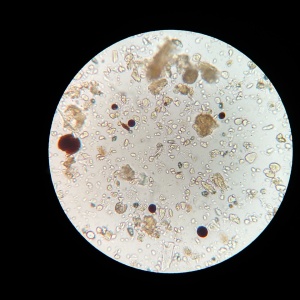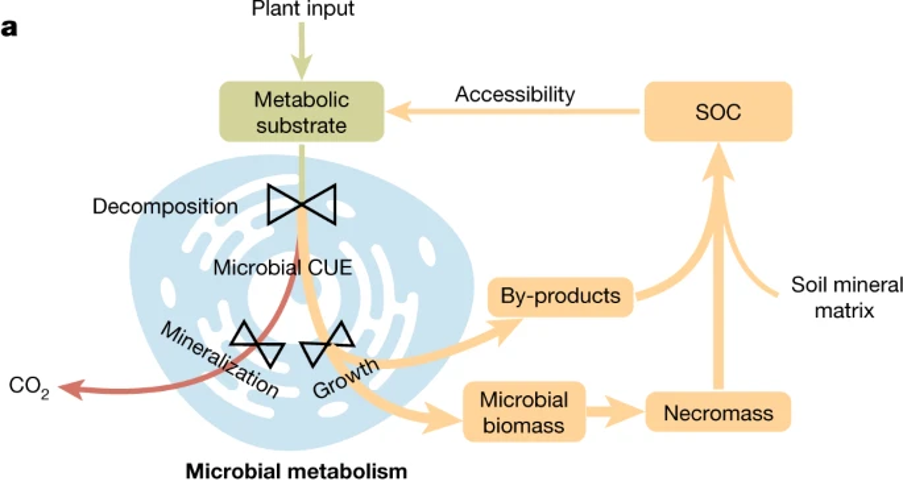
Soil carbon sequestration involves carbon dioxide being removed from the atmosphere and stored in the soil as soil organic carbon (SOC). This process has been shown to help mitigate climate change; however exactly how SOC forms and persists remains uncertain. This study aims to uncover the role soil microorganisms play in SOC formation, preservation and loss.
Microorganisms affect the flux of organic matter within the soil through various pathways. The microbial carbon use efficiency (CUE) metric has been used in previous studies to understand these processes. Microbial CUE compares the amount of carbon used for microbial growth versus the amount used for respiration. However, the exact role of CUE in the process of SOC storage remains unclear. In particular, questions remain over whether high microbial CUE promotes or inhibits SOC storage and how this relationship links to other environmental factors. Thus, this study examines the relationship between microbial CUE and SOC preservation and how this links to climate, vegetation and soil properties.
An initial meta-analysis of 132 paired measurements of CUE and SOC content (at 46 locations globally from 16 previous studies) showed that a high microbial CUE promotes increased SOC storage. The image below illustrates how this might occur: whilst some carbon dioxide is released during respiration, the build-up of dead microbes (necromass) and by-products in the soil during growth leads to net increases in SOC.

Image: Panel a, Figure 1, Tao et al., 2023. This pathway indicates that a high CUE favours the accumulation of SOC storage through increased microbial biomass and by-products. Click here for full figure.
Next the authors developed a novel computer model that uses data assimilation and machine learning to analyse global SOC data. This model was used to assess the importance of microbial CUE compared to six other factors known to impact SOC storage (including carbon inputs from plants, decomposition, and transport of carbon to different soil depths). Ultimately, microbial CUE was shown to be at least four times as important as the other factors in determining SOC storage and its spatial variation across the globe.
Overall, this study showed that growth of microbes is one of the most important factors in determining how much carbon is stored in the soil. The finding that high microbial CUE effectively promotes SOC storage is particularly crucial because it will help better predict how soil carbon sequestration will be affected by a changing climate. Moreover, it presents a starting point for future studies to use microbes to promote the formation of soil carbon ‘sinks’ which improve ‘soil health’ and aid climate change mitigation.
Abstract
Soils store more carbon than other terrestrial ecosystems. How soil organic carbon (SOC) forms and persists remains uncertain, which makes it challenging to understand how it will respond to climatic change. It has been suggested that soil microorganisms play an important role in SOC formation, preservation and loss. Although microorganisms affect the accumulation and loss of soil organic matter through many pathways, microbial carbon use efficiency (CUE) is an integrative metric that can capture the balance of these processes. Although CUE has the potential to act as a predictor of variation in SOC storage, the role of CUE in SOC persistence remains unresolved. Here we examine the relationship between CUE and the preservation of SOC, and interactions with climate, vegetation and edaphic properties, using a combination of global-scale datasets, a microbial-process explicit model, data assimilation, deep learning and meta-analysis. We find that CUE is at least four times as important as other evaluated factors, such as carbon input, decomposition or vertical transport, in determining SOC storage and its spatial variation across the globe. In addition, CUE shows a positive correlation with SOC content. Our findings point to microbial CUE as a major determinant of global SOC storage. Understanding the microbial processes underlying CUE and their environmental dependence may help the prediction of SOC feedback to a changing climate.
Reference
Tao, F., Huang, Y., Hungate, B.A., et al., (2023) Microbial carbon use efficiency promotes global soil carbon storage. Nature.
Read the full paper here. See also the 2017 FCRN report Grazed and Confused.







Post a new comment »